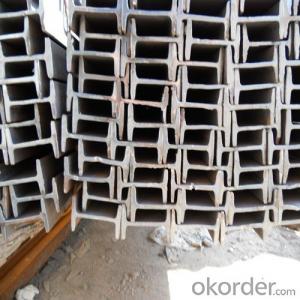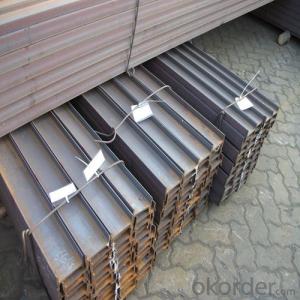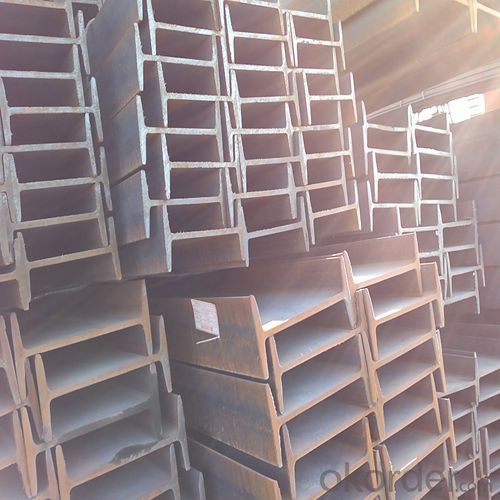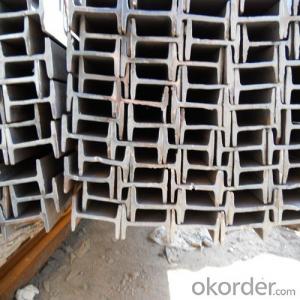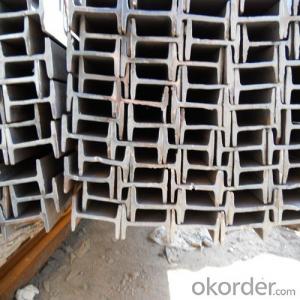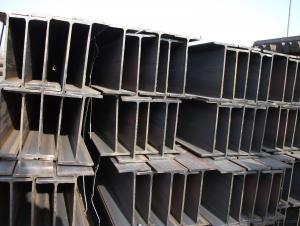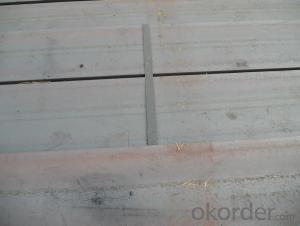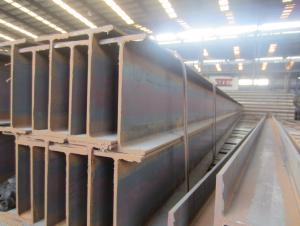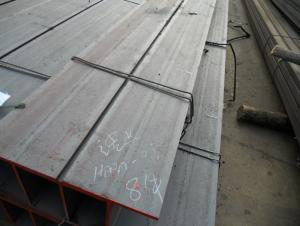H-Beam Structure Steel -JIS Standard GB Standard
- Loading Port:
- Tianjin
- Payment Terms:
- TT or LC
- Min Order Qty:
- 50 m.t.
- Supply Capability:
- 50000 m.t./month
OKorder Service Pledge
OKorder Financial Service
You Might Also Like
Product Description:
OKorder is offering H-Beam Structure Steel -JIS Standard GB Standard at great prices with worldwide shipping. Our supplier is a world-class manufacturer of steel, with our products utilized the world over. OKorder annually supplies products to European, North American and Asian markets. We provide quotations within 24 hours of receiving an inquiry and guarantee competitive prices.
Product Applications:
H-Beam Structure Steel -JIS Standard GB Standard are ideal for structural applications and are widely used in the construction of buildings and bridges, and the manufacturing, petrochemical, and transportation industries.
Product Advantages:
OKorder's H-Beam Structure Steel -JIS Standard GB Standard are durable, strong, and resist corrosion.
Main Product Features:
· Premium quality
· Prompt delivery & seaworthy packing (30 days after receiving deposit)
· Corrosion resistance
· Can be recycled and reused
· Mill test certification
· Professional Service
· Competitive pricing
Product Specifications:
Specifications of Hot Rolled Structural Steel H Beam
1. Standard: GB700-88, Q235B2.
2. Grade: Q235, SS400 or Equivalent
3. Length: 6m,10m, 12m as following table
4. Invoicing on theoretical weight or actual weight as customer request
5.Payment: TT or L/C
6. Sizes:
SIZE(mm) | DIMENSION(kg/m) |
100*100 | 16.9 |
125*125 | 23.6 |
150*75 | 14 |
150*150 | 31.1 |
148*100 | 20.7 |
198*99 | 17.8 |
200*100 | 20.9 |
248*124 | 25.1 |
250*125 | 29 |
Usage & Applications of Hot Rolled Structural Steel H Beam
Commercial building structure ;Pre-engineered buildings; Machinery support structure; Prefabricated structure; Medium scale bridges; Ship-building structure. etc.
Packaging & Delivery of Hot Rolled Structural Steel H Beam
1. Packing: it is nude packed in bundles by steel wire rod
2. Bundle weight: not more than 3.5MT for bulk vessel; less than 3 MT for container load
3. Marks:
Color marking: There will be color marking on both end of the bundle for the cargo delivered by bulk vessel. That makes it easily to distinguish at the destination port.
Tag mark: there will be tag mark tied up on the bundles. The information usually including supplier logo and name, product name, made in China, shipping marks and other information request by the customer.
If loading by container the marking is not needed, but we will prepare it as customer request.
4. Transportation: the goods are delivered by truck from mill to loading port, the maximum quantity can be loaded is around 40MTs by each truck. If the order quantity cannot reach the full truck loaded, the transportation cost per ton will be little higher than full load.
5. Delivered by container or bulk vessel
Production flow of Hot Rolled Structural Steel H Beam
Material prepare (billet) —heat up—rough rolling—precision rolling—cooling—packing—storage and transportation
FAQ:
Q1: Why buy Materials & Equipment from OKorder.com?
A1: All products offered byOKorder.com are carefully selected from China's most reliable manufacturing enterprises. Through its ISO certifications, OKorder.com adheres to the highest standards and a commitment to supply chain safety and customer satisfaction.
Q2: How do we guarantee the quality of our products?
A2: We have established an advanced quality management system which conducts strict quality tests at every step, from raw materials to the final product. At the same time, we provide extensive follow-up service assurances as required.
Q3: How soon can we receive the product after purchase?
A3: Within three days of placing an order, we will begin production. The specific shipping date is dependent upon international and government factors, but is typically 7 to 10 workdays.
Q4: What makes stainless steel stainless?
A4: Stainless steel must contain at least 10.5 % chromium. It is this element that reacts with the oxygen in the air to form a complex chrome-oxide surface layer that is invisible but strong enough to prevent further oxygen from "staining" (rusting) the surface. Higher levels of chromium and the addition of other alloying elements such as nickel and molybdenum enhance this surface layer and improve the corrosion resistance of the stainless material.
Q5: Can stainless steel rust?
A5: Stainless does not "rust" as you think of regular steel rusting with a red oxide on the surface that flakes off. If you see red rust it is probably due to some iron particles that have contaminated the surface of the stainless steel and it is these iron particles that are rusting. Look at the source of the rusting and see if you can remove it from the surface.
Images:
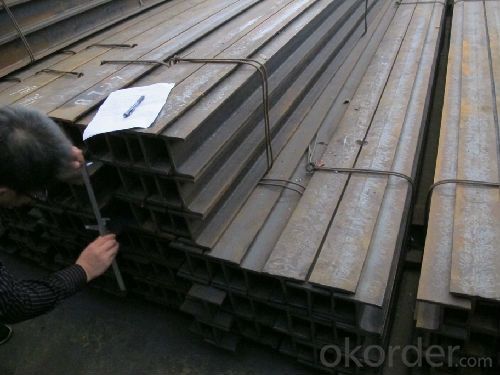
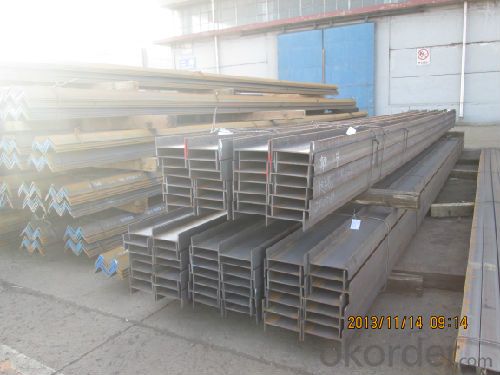

- Q: What are the different types of welding used for steel H-beams?
- Steel H-beams can be welded using different techniques, depending on their specific requirements and applications. The commonly used welding methods for steel H-beams are as follows: 1. SMAW (Shielded Metal Arc Welding), also known as stick welding, involves using a consumable electrode with a flux coating to create an electric arc between the electrode and the base metal. This versatile technique is widely used for various steel applications, including H-beams. 2. GMAW (Gas Metal Arc Welding), also referred to as MIG (Metal Inert Gas) welding, utilizes a continuously fed wire electrode and a shielding gas to protect the weld pool from atmospheric contamination. It offers excellent control over the welding process and a high deposition rate, making it suitable for H-beam fabrication. 3. FCAW (Flux-Cored Arc Welding) is similar to GMAW but uses a tubular wire electrode filled with flux to shield the weld pool from impurities. It is preferred for its high welding speed and ability to handle thicker steel plates, making it suitable for heavy-duty applications involving H-beams. 4. SAW (Submerged Arc Welding) involves creating an arc between a continuously fed bare electrode and the base metal. The weld area is shielded by a granular flux layer that submerges the arc, preventing atmospheric contamination. SAW is commonly used for fabricating large and thick H-beams due to its high deposition rate and deep penetration capabilities. 5. LBW (Laser Beam Welding) uses a high-energy laser beam to melt and fuse the base metal. This precise and controlled method is often used for thinner H-beams or when intricate welding patterns and minimal heat-affected zones are required. It is important to consider various factors such as beam thickness, steel type, intended application, and desired welding speed and quality when choosing the appropriate welding technique for a specific H-beam project. Consulting a welding professional or referring to industry standards and guidelines is recommended to ensure the most suitable method is selected.
- Q: Are steel H-beams suitable for automotive assembly plants?
- Yes, steel H-beams are suitable for automotive assembly plants. They are commonly used in the construction of industrial buildings, including automotive assembly plants, due to their strength, durability, and ability to withstand heavy loads. Steel H-beams provide structural support, allowing for the creation of large open spaces and efficient assembly line layouts.
- Q: How do Steel H-Beams compare in terms of lifespan and durability?
- The exceptional lifespan and durability of steel H-Beams are well-known. These structural members are specifically designed to withstand heavy loads and provide long-lasting support for various construction projects. Unlike wood or concrete, the lifespan of steel H-Beams can be significantly longer. The durability of steel H-Beams can be attributed to several key factors. Firstly, steel itself is inherently strong, with superior tensile strength and resistance to bending and twisting forces. This enables the H-Beams to endure extreme weather conditions, seismic activity, and other external factors that could potentially damage structures over time. Moreover, steel H-Beams are not susceptible to rot, decay, or insect infestations like wooden beams. They also do not degrade or weaken under moisture, a common issue with concrete structures. This makes steel H-Beams highly durable and reliable, ensuring their long-term performance and structural integrity. Additionally, steel H-Beams are resistant to fire, further enhancing their lifespan and durability. Steel has a high melting point and does not contribute fuel to a fire, making it a safer choice for structural elements. This characteristic is particularly important in high-rise buildings or structures where fire protection is crucial. Furthermore, steel H-Beams can be easily inspected for signs of wear or damage. Regular maintenance and inspections can help identify and address any issues promptly, ensuring the continued durability and longevity of these structural members. In conclusion, steel H-Beams possess remarkable lifespan and durability due to their high strength, resistance to environmental factors, and fire resistance. These qualities make them an excellent choice for a wide range of construction projects where longevity and structural integrity are of utmost importance.
- Q: Can steel H-beams be used in museum or art gallery construction?
- Yes, steel H-beams can be used in museum or art gallery construction. They are a common choice for structural support due to their strength, durability, and ability to support heavy loads. Steel H-beams can provide the necessary stability and structural integrity required for large open spaces, allowing for flexible and creative design possibilities in museum or art gallery construction.
- Q: Can steel H-beams be used in automotive manufacturing?
- Yes, steel H-beams can be used in automotive manufacturing. H-beams, also known as I-beams or universal beams, are commonly used in the construction industry for their strength and durability. However, they can also be utilized in automotive manufacturing for various applications. For example, H-beams can be used in the construction of vehicle frames, chassis, and suspension systems. They provide excellent structural support and can withstand heavy loads and impacts, making them ideal for ensuring the safety and stability of the vehicle. Additionally, H-beams can be used in the manufacturing of engine components, such as connecting rods and crankshafts, as they possess high tensile strength and are resistant to bending and twisting forces. Furthermore, steel H-beams offer other advantages such as cost-effectiveness, availability, and ease of fabrication. They can be readily sourced from steel suppliers and are available in a wide range of sizes and specifications, making them suitable for various automotive applications. Additionally, steel is a recyclable material, aligning with the automotive industry's increasing emphasis on sustainability and environmental consciousness. In summary, steel H-beams can indeed be used in automotive manufacturing due to their strength, durability, versatility, and cost-effectiveness. Their utilization in vehicle frames, suspension systems, and engine components contributes to the overall safety, stability, and performance of automobiles.
- Q: Can steel H-beams be used for bridge construction?
- Yes, steel H-beams can be used for bridge construction. They are often preferred due to their high strength-to-weight ratio, durability, and ability to withstand heavy loads. Steel H-beams provide excellent structural support for bridges, making them a popular choice in the construction industry.
- Q: What are the specifications for H steel HW, HB, HN?
- HW is a H type steel flange height and width substantially equal; mainly used for reinforced concrete frame column steel column, also known as rigid steel column; column is mainly used in steel structure.
- Q: What are the guidelines for handling and installing steel H-beams?
- When it comes to handling and installing steel H-beams, there are several guidelines that should be followed to ensure safety and proper installation. These guidelines include: 1. Planning and preparation: Before starting the installation process, it is crucial to carefully plan and prepare the site. This includes determining the appropriate size and type of H-beam required for the specific project, as well as ensuring that the installation site is properly prepared and level. 2. Inspection: Before handling or installing steel H-beams, a thorough inspection should be conducted to ensure that they are free from any defects, such as cracks, bends, or other structural damage. Any H-beams with defects should be rejected and replaced. 3. Handling: Steel H-beams can be heavy and require proper handling techniques to prevent injuries. It is important to use appropriate lifting equipment, such as cranes or forklifts, and to follow safe lifting practices. Additionally, H-beams should be stored in a way that prevents them from rolling or falling. 4. Alignment: During installation, it is crucial to ensure that the H-beams are properly aligned. This can be achieved by using alignment guides or laser levels to ensure that the beams are straight and in the correct position. 5. Connection: Steel H-beams are typically connected using bolted connections. It is important to follow the manufacturer's guidelines for the correct size and type of bolts to be used, as well as the recommended torque values. Properly tightening the bolts will ensure a secure connection and prevent any movement or shifting of the beams. 6. Welding: In some cases, welding may be required to connect the H-beams. If welding is necessary, it should be performed by qualified welders who follow industry standards and guidelines. Welds should be inspected for quality and integrity. 7. Safety precautions: Throughout the entire process of handling and installing steel H-beams, it is important to prioritize safety. This includes wearing appropriate personal protective equipment (PPE), such as hard hats and safety glasses, and following all safety protocols and regulations. By following these guidelines, the handling and installation of steel H-beams can be carried out safely and effectively, ensuring the structural integrity of the project. It is always recommended to consult with professionals or engineers experienced in steel construction for specific guidance and to ensure compliance with local building codes and regulations.
- Q: Can steel H-beams be used for retaining walls?
- Yes, steel H-beams can be used for retaining walls. They are commonly used in construction for their strength and durability, and their shape allows for efficient load-bearing capabilities. Steel H-beams provide stability and support, making them a suitable choice for retaining walls in various applications.
- Q: How do steel H-beams perform in extreme temperature variations?
- Steel H-beams exhibit exceptional performance in the face of extreme temperature fluctuations. Their inherent qualities, namely their high strength and durability, render them highly resistant to thermal expansion and contraction. As a result, steel H-beams retain their structural integrity and dimensional stability even when exposed to drastic temperature changes. In colder temperatures, steel H-beams remain resilient and maintain their strength. This is due to steel's low coefficient of thermal expansion, which means that it expands and contracts less than other materials when subjected to temperature variations. Consequently, steel H-beams prove to be highly suitable for applications in colder climates where significant temperature fluctuations occur. Their ability to withstand freezing temperatures without compromising performance is truly remarkable. Similarly, in hotter temperatures, steel H-beams retain their load-bearing capacity and do not weaken. Steel possesses a high melting point, enabling it to endure high temperatures without deforming or failing. This quality makes steel H-beams an ideal choice for areas with elevated ambient temperatures, where concerns about thermal expansion arise. Additionally, steel H-beams exhibit exceptional fire resistance properties. They are non-combustible and do not contribute to the spread of fire, making them a safe option for structures located in regions prone to wildfires or other fire hazards. It is important to recognize that while steel H-beams can endure extreme temperature variations, other factors such as the structure's design, fabrication, and installation should also be considered to ensure optimal performance. Proper insulation, thermal breaks, and structural design considerations can further enhance the performance of steel H-beams in extreme temperature conditions.
Send your message to us
H-Beam Structure Steel -JIS Standard GB Standard
- Loading Port:
- Tianjin
- Payment Terms:
- TT or LC
- Min Order Qty:
- 50 m.t.
- Supply Capability:
- 50000 m.t./month
OKorder Service Pledge
OKorder Financial Service
Similar products
Hot products
Hot Searches
Related keywords
